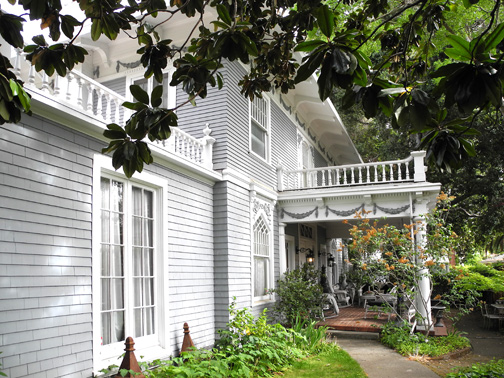 Palo Alto Stanford Heritage
Palo Alto Stanford Heritage 
The Dayan mansion at 449 Seneca was one of the first to be built on the 698 acres which Timothy Hopkins had purchased to accommodate Leland Stanford’s dream of a “dry” University town. Built in 1895 and set in extensive landscaped grounds with a palm–lined drive, the house originally faced University Avenue.
449 Seneca is an excellent example of the formality and dignity of the Georgian Revival which had begun to replace the more ornate Queen Anne and Victorian styles. Under the wide bracketed eaves is a decorative frieze, which is repeated above the windows. The delicate, carved ornamentation is a standard Georgian motif although there are deviations from the expected in some window shapes and in the rear porch. The main entrance, now on the side, has a columned portico which opens into an extravagantly large reception hall. The Dayan House’s interior is architecturally consistent in its grandeur.
Judge Walton Dayan and Martha Isabelle Dayan, originally from Illinois, came to Palo Alto in 1891 and lived at 449 Seneca from 1895 until 1916. Mr. Dayan had bought nearly an acre of land on University Avenue soon after the tract was put on sale. He was an officer of the Southern Pacific Railroad for many years. This pioneering couple championed the development of their new town: she led the Woman’s Club project of landscaping along University Avenue, Alma Street and the train depot while her husband arranged for graveling the streets. Both were founders of the Improvement Club.
How could such a respectable couple become the fulcrum of scandal in their adopted town? Martha Dayan, formerly married in Illinois to a Mr. Clemmons, had two daughters by that marriage—Ella May Clemmons (1861–1935) and Viola Katherine Clemmons (1874–1930). Coming to Palo Alto at the ages of 31 and 17, the daughters kept books for their stepfather. Katherine, having no intention of eternally adding up numbers, left for San Francisco. There she became a protégé of William F. Cody aka Buffalo Bill and went swiftly from a role in a Shakespearian play to international stardom. Ella Mae accompanied her as chaperone. The sisters argued and Ella Mae returned to San Francisco in 1897 where she founded a Montessori kindergarten for Chinese children.
Katherine, described as “a blonde, with liquid blue eyes and an abundance of blonde hair” and having lopped 10 years off her age, won both the heart of Europe and that of Howard Gould, heir to a $10 million fortune from his Robber Baron father, Jay Gould. Despite his family’s objection, Harold and Katherine wed in 1898. Eleven years later, Gould, charging alcoholism and infidelity with Buffalo Bill, divorced Katherine. Gould was ordered to pay alimony of $36,000/year—a princely sum in 1909. Katherine retired to a Maryland farm where she raised thoroughbreds, wrote a book, contributed to periodicals and ignored her sister.
Ella Mae, meanwhile, contributed to the Dayan drama through good works and multiple marriages. Married and divorced twice in Illinois, she would marry twice again in California. When the 1906 earthquake toppled San Francisco, Ella dug her Chinese kindergarteners out of the debris and installed them in army tents at the Presidio. Her own tent, decorated with a crucifix and a picture of her famous sister, was where she met husband #3. Wong Sun Yue was a middle aged Chinese refugee and opium addict when he begged aid for Chinatown residents from Ella. Although Wong had a wife in China, Ella Mae moved in with him explaining that she had to be with him constantly to cure his opium habit. To quell what became a 10 year long, bi–racial scandal, Katherine too accompanied Ella and Wong to Bejing in 1916 where she financed a Montessori school. Once again, the sisters fought, Katherine left, Wong reunited with his Chinese wife and Ella returned to San Francisco to live the life of a recluse.
449 Seneca is listed on Palo Alto’s Historic Inventory and the lives of its inhabitants are worthy of a soap opera. ©
PAST, April 26, 2013
| |
E-mail us at either webmaster@pastheritage.org or president@pastheritage.org.
![]() Palo Alto Stanford Heritage—Dedicated to the preservation of Palo Alto's historic buildings.
Palo Alto Stanford Heritage—Dedicated to the preservation of Palo Alto's historic buildings.
Copyright © 2015 Palo Alto Stanford Heritage. All rights reserved.